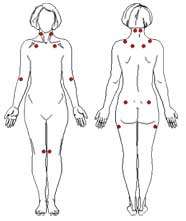Fibromyalgia
Find your care
At the UCLA Health Spine Center, our experts diagnose, manage and treat all spinal injuries and conditions. Call 310-319-3475 to connect with a spine specialist.
Fax: 424-259-6560
What You Should Know About Fibromyalgia
Fibromyalgia (FM) is a diagnosis made if no spine pathology or other diagnoses can be made with usual diagnostic imaging or laboratory studies. FM is an increasingly recognized chronic pain illness, which is characterized by widespread musculoskeletal aches, pain, and stiffness; soft tissue tenderness; general fatigue, and sleep disturbances. The most common sites of pain include the neck, back, shoulders, pelvic girdle, and hands, but any body part can be involved.

Symptoms
FM presents itself in intense, chronic pain that can spread to all parts of the body. Patients also complain of deep aching, numbness, tingling, and a burning sensation. Pain symptoms are often worse in the morning and intensified by cold/humid weather, non-restorative sleep, physical and mental fatigue, excessive physical activity, physical inactivity, and anxiety and stress. FM sufferers also experience extreme fatigue, irritable bowel and bladder, headaches and migraines, restless leg syndrome (periodic limb movement disorder), impaired memory and concentration, skin sensitivities and rashes, dry eyes and mouth, anxiety, depression, ringing in the ears, dizziness, vision problems, Raynaud's syndrome, neurological symptoms, and impaired coordination.
Diagnosis
Currently there are no laboratory tests available for diagnosing FM. Doctors must rely on patient histories, self-reported symptoms, a physical examination, and an accurate manual tender point examination. This exam is based on the standardized ACR criteria. Proper implementation of the exam determines the presence of multiple tender points at characteristic locations.
Treatment
FM is a chronic condition, with various methods used to decrease the intensity of symptoms. Physical therapy, pain management, and lifestyle adjustments in nutrition and exercise are ongoing needs of FM sufferers. It is estimated that 3-6% of the population suffers from this condition in some form or another. With proper treatment and attention, most patients show improvement over time. New research and attention to FM continues to improve the prognosis.